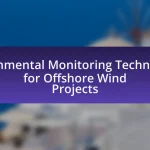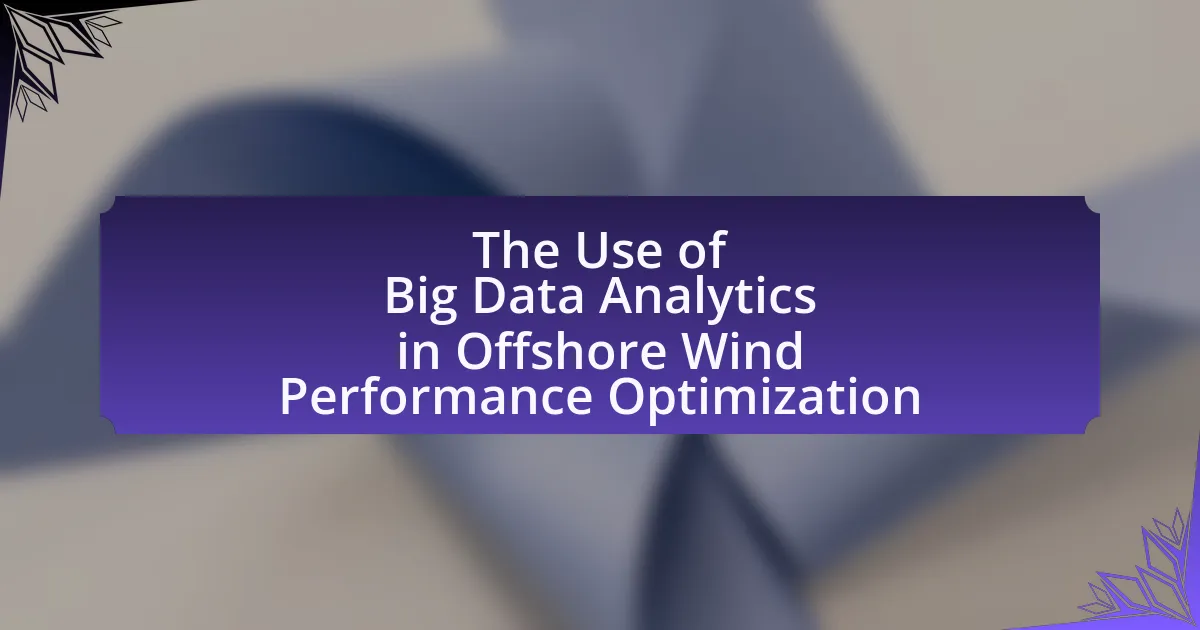Offshore wind energy, a renewable energy source generated from wind turbines in marine environments, is increasingly recognized for its potential to reduce greenhouse gas emissions and enhance energy security. The integration of blockchain technology, a decentralized digital ledger, with offshore wind energy can significantly improve energy trading efficiency, supply chain management, and real-time monitoring of energy production and consumption. This article explores the intersection of these two technologies, highlighting their benefits, challenges, and the implications for energy consumers, producers, and investors, while also addressing current trends and future prospects in the energy sector. Additionally, it discusses the environmental impacts, market opportunities, and best practices for successful implementation of offshore wind energy and blockchain technology.
What is Offshore Wind Energy and Blockchain Technology?
Offshore wind energy refers to the generation of electricity from wind turbines located in bodies of water, typically on the continental shelf, where wind speeds are higher and more consistent than on land. This renewable energy source has gained traction due to its potential to significantly reduce greenhouse gas emissions and contribute to energy security. Blockchain technology, on the other hand, is a decentralized digital ledger that securely records transactions across multiple computers, ensuring transparency and reducing the risk of fraud. The integration of blockchain with offshore wind energy can enhance the efficiency of energy trading, improve supply chain management, and facilitate real-time monitoring of energy production and consumption, thereby optimizing the overall operation of offshore wind farms.
How do Offshore Wind Energy and Blockchain Technology intersect?
Offshore wind energy and blockchain technology intersect primarily through the enhancement of energy trading and management systems. Blockchain can facilitate transparent, decentralized energy transactions, allowing offshore wind farms to sell energy directly to consumers or businesses without intermediaries. This technology ensures secure and verifiable transactions, which is crucial for managing the complex supply chains and regulatory requirements associated with offshore wind energy. For instance, a study by the International Renewable Energy Agency highlights that blockchain can improve the efficiency of renewable energy certificates, enabling better tracking and trading of energy produced by offshore wind farms.
What are the key components of Offshore Wind Energy?
The key components of offshore wind energy include wind turbines, substructures, electrical systems, and support vessels. Wind turbines convert wind energy into electricity, while substructures, such as monopiles or jackets, provide stability and support in marine environments. Electrical systems, including underwater cables and substations, facilitate the transmission of generated electricity to the grid. Support vessels are essential for installation, maintenance, and operation of the wind farms. These components work together to harness wind energy efficiently and sustainably in offshore locations.
What role does Blockchain Technology play in energy management?
Blockchain technology plays a crucial role in energy management by enabling decentralized energy trading and enhancing transparency in transactions. This technology allows for peer-to-peer energy exchanges, where consumers can buy and sell excess energy directly, reducing reliance on traditional energy providers. Additionally, blockchain ensures secure and immutable records of energy transactions, which improves trust among participants and facilitates regulatory compliance. For instance, projects like Power Ledger have demonstrated how blockchain can optimize energy distribution and empower users to manage their energy consumption more effectively.
Why is the integration of Offshore Wind Energy and Blockchain Technology important?
The integration of Offshore Wind Energy and Blockchain Technology is important because it enhances the efficiency, transparency, and security of energy transactions. Offshore wind energy generates significant amounts of renewable power, and blockchain technology can facilitate real-time tracking of energy production and consumption, ensuring that energy is accurately accounted for and traded. This integration can also streamline the management of decentralized energy systems, allowing for peer-to-peer energy trading and reducing reliance on centralized energy providers. Studies indicate that blockchain can reduce transaction costs by up to 40%, making renewable energy more accessible and economically viable.
What challenges does the energy sector face that this integration addresses?
The integration of blockchain technology in the energy sector addresses challenges such as inefficiencies in energy trading, lack of transparency, and difficulties in managing decentralized energy resources. Blockchain enhances transaction speed and reduces costs by enabling peer-to-peer energy trading, which allows consumers to buy and sell energy directly. Additionally, it provides a transparent and immutable ledger that improves trust among stakeholders, thereby addressing issues related to fraud and data manipulation. According to a report by the International Renewable Energy Agency, blockchain can streamline operations and enhance the integration of renewable energy sources, ultimately leading to a more resilient and efficient energy system.
How can Blockchain enhance the efficiency of Offshore Wind Energy projects?
Blockchain can enhance the efficiency of offshore wind energy projects by providing transparent and immutable records of transactions and data sharing among stakeholders. This technology facilitates real-time monitoring of energy production, maintenance schedules, and supply chain logistics, which reduces downtime and operational costs. For instance, a study by the International Renewable Energy Agency (IRENA) highlights that blockchain can streamline the management of renewable energy certificates, ensuring accurate tracking and trading, thus optimizing financial flows within the project. Additionally, the decentralized nature of blockchain enhances collaboration among various parties, including developers, operators, and regulators, leading to improved decision-making and project execution.
What are the benefits of combining Offshore Wind Energy with Blockchain Technology?
Combining offshore wind energy with blockchain technology enhances transparency, efficiency, and security in energy transactions. Blockchain enables real-time tracking of energy production and consumption, ensuring that all stakeholders have access to accurate data. This transparency can lead to increased trust among investors and consumers, as well as streamlined regulatory compliance. Additionally, smart contracts on blockchain can automate transactions, reducing administrative costs and time delays associated with traditional energy trading. According to a report by the International Renewable Energy Agency, integrating blockchain with renewable energy systems can potentially lower transaction costs by up to 30%, making offshore wind energy more economically viable.
How does this combination improve energy distribution?
The combination of offshore wind energy and blockchain technology improves energy distribution by enhancing transparency and efficiency in energy transactions. Blockchain enables real-time tracking of energy production and consumption, allowing for more accurate matching of supply and demand. This technology facilitates peer-to-peer energy trading, where consumers can buy and sell excess energy directly, reducing reliance on centralized grids. Studies show that integrating blockchain with renewable energy sources can increase grid resilience and optimize energy flow, leading to a more balanced distribution of energy resources.
What are the implications for energy consumers?
The implications for energy consumers regarding offshore wind energy and blockchain technology include increased access to renewable energy, enhanced transparency in energy transactions, and potential cost savings. Offshore wind energy provides a sustainable power source, which can lead to lower energy bills as the reliance on fossil fuels decreases. Blockchain technology facilitates peer-to-peer energy trading, allowing consumers to buy and sell energy directly, thus promoting competition and potentially lowering prices. Additionally, the transparency offered by blockchain can help consumers track energy sources and verify the sustainability of their energy supply, fostering informed choices.
How does it affect energy producers and investors?
Offshore wind energy and blockchain technology significantly impact energy producers and investors by enhancing operational efficiency and transparency. Energy producers can utilize blockchain to streamline supply chain management, reduce costs, and improve data accuracy, which can lead to increased profitability. For instance, a study by the International Renewable Energy Agency (IRENA) highlights that integrating blockchain can reduce transaction costs by up to 30% in energy trading. Investors benefit from the increased reliability and transparency of energy transactions, which can lead to more informed decision-making and potentially higher returns on investment. The combination of these technologies fosters a more competitive market, attracting further investment into offshore wind projects.
What environmental impacts can be mitigated through this integration?
The integration of offshore wind energy and blockchain technology can mitigate several environmental impacts, primarily by enhancing energy efficiency and reducing carbon emissions. By optimizing energy distribution and management through blockchain, the integration can minimize energy waste and improve the reliability of renewable energy sources. This efficiency leads to a decrease in reliance on fossil fuels, thereby lowering greenhouse gas emissions. Additionally, blockchain can facilitate better tracking of energy production and consumption, promoting transparency and accountability in renewable energy usage, which further supports environmental sustainability.
How does Offshore Wind Energy contribute to sustainability?
Offshore wind energy contributes to sustainability by providing a renewable source of electricity that reduces greenhouse gas emissions. This form of energy harnesses wind power over oceans, where wind speeds are typically higher and more consistent than on land, leading to greater energy generation efficiency. According to the International Renewable Energy Agency, offshore wind energy can reduce carbon dioxide emissions by up to 1.1 billion tons annually by 2040 if fully deployed. Additionally, offshore wind farms have a smaller land footprint compared to traditional energy sources, preserving terrestrial ecosystems.
What role does Blockchain play in tracking environmental benefits?
Blockchain plays a crucial role in tracking environmental benefits by providing a transparent and immutable ledger for recording data related to sustainability initiatives. This technology enables stakeholders in offshore wind energy projects to monitor and verify the environmental impact of their operations, such as carbon offsetting and energy production metrics. For instance, blockchain can facilitate the tracking of renewable energy certificates, ensuring that the energy produced is accurately accounted for and attributed to specific projects. This level of transparency not only enhances accountability but also fosters trust among investors, regulators, and the public, ultimately supporting the transition to cleaner energy sources.
What are the current trends and future prospects for Offshore Wind Energy and Blockchain Technology?
Current trends in offshore wind energy include significant investments in technology and infrastructure, with global capacity expected to reach 234 GW by 2030, driven by countries like China, the UK, and the US. The integration of blockchain technology is emerging as a method to enhance transparency and efficiency in energy trading and grid management, allowing for real-time data sharing and smart contracts. Future prospects indicate that as offshore wind farms expand, blockchain could facilitate decentralized energy markets, enabling peer-to-peer trading and optimizing energy distribution. This synergy between offshore wind energy and blockchain technology is poised to revolutionize the energy sector, promoting sustainability and reducing costs.
What innovations are emerging in this field?
Emerging innovations in the field of offshore wind energy and blockchain technology include the integration of blockchain for enhanced energy trading and management. This integration allows for real-time tracking of energy production and consumption, facilitating peer-to-peer energy trading among consumers and producers. Additionally, smart contracts on blockchain platforms automate transactions, reducing administrative costs and increasing efficiency in energy distribution. Research indicates that using blockchain can improve transparency and security in energy transactions, as evidenced by projects like Power Ledger, which has successfully implemented blockchain solutions in energy markets.
How are governments and organizations supporting these innovations?
Governments and organizations are supporting innovations in offshore wind energy and blockchain technology through funding, policy frameworks, and collaborative initiatives. For instance, various governments have allocated billions in subsidies and grants to promote renewable energy projects, with the European Union committing over €24 billion to offshore wind projects by 2030. Additionally, organizations are forming partnerships to integrate blockchain technology for improving energy trading and grid management, exemplified by the collaboration between the Energy Web Foundation and various energy companies to develop decentralized energy solutions. These efforts demonstrate a concerted push towards enhancing the efficiency and sustainability of energy systems.
What are the potential market opportunities?
The potential market opportunities in offshore wind energy and blockchain technology include enhanced energy trading, improved supply chain transparency, and optimized asset management. The integration of blockchain can facilitate peer-to-peer energy trading, allowing consumers to buy and sell energy directly, which can increase market efficiency and reduce costs. Additionally, blockchain’s ability to provide immutable records can enhance transparency in the supply chain, ensuring that all stakeholders have access to accurate data regarding energy production and consumption. According to a report by the International Renewable Energy Agency, the offshore wind sector is expected to grow significantly, with global capacity projected to reach 234 GW by 2030, indicating a robust market for innovative technologies like blockchain to support this growth.
What barriers exist to the widespread adoption of this integration?
Barriers to the widespread adoption of integrating offshore wind energy with blockchain technology include regulatory challenges, high initial costs, and technological complexity. Regulatory challenges arise from the need for clear policies and standards that govern both offshore wind energy and blockchain applications, which are often lacking or inconsistent across regions. High initial costs are associated with the investment required for both the infrastructure of offshore wind farms and the implementation of blockchain systems, which can deter stakeholders. Additionally, the technological complexity of integrating these two advanced systems can lead to difficulties in interoperability and scalability, hindering adoption.
How can regulatory challenges be addressed?
Regulatory challenges can be addressed by implementing collaborative frameworks that involve stakeholders from government, industry, and communities. These frameworks facilitate dialogue and create a shared understanding of regulatory requirements, which can lead to more effective and adaptive regulations. For instance, the European Union has established the Clean Energy for All Europeans package, which encourages member states to work together on energy regulations, thereby streamlining processes and reducing bureaucratic hurdles. This collaborative approach not only enhances compliance but also fosters innovation in sectors like offshore wind energy and blockchain technology, ensuring that regulations keep pace with technological advancements.
What technological hurdles need to be overcome?
The technological hurdles that need to be overcome in the integration of offshore wind energy and blockchain technology include scalability, interoperability, and data security. Scalability is essential to ensure that blockchain systems can handle the vast amounts of data generated by offshore wind farms, which can produce significant energy outputs and require real-time monitoring. Interoperability is crucial for enabling different blockchain platforms and energy management systems to communicate effectively, facilitating seamless transactions and data sharing across various stakeholders. Data security is paramount to protect sensitive information related to energy production and financial transactions from cyber threats, as the energy sector increasingly relies on digital solutions. Addressing these hurdles is vital for the successful implementation of blockchain technology in the offshore wind energy sector, as evidenced by ongoing research and pilot projects aimed at enhancing these aspects.
What best practices should stakeholders consider when implementing these technologies?
Stakeholders should prioritize collaboration and communication when implementing offshore wind energy and blockchain technologies. Effective collaboration among stakeholders, including developers, regulators, and local communities, ensures that diverse perspectives are integrated into project planning and execution. Additionally, establishing clear communication channels facilitates transparency and trust, which are essential for addressing concerns and fostering stakeholder engagement.
Moreover, stakeholders should invest in training and education to enhance understanding of both technologies, as this knowledge is crucial for effective implementation. Research indicates that projects with well-informed teams are more likely to succeed, as they can navigate challenges more effectively.
Lastly, stakeholders must adhere to regulatory frameworks and best practices in both offshore wind energy and blockchain technology to ensure compliance and sustainability. For instance, the International Renewable Energy Agency emphasizes the importance of aligning projects with environmental standards to mitigate risks and enhance project viability.
How can collaboration between sectors enhance outcomes?
Collaboration between sectors can enhance outcomes by leveraging diverse expertise and resources to drive innovation and efficiency. For instance, in the context of offshore wind energy and blockchain technology, partnerships between energy companies, technology firms, and regulatory bodies can streamline operations, improve data transparency, and optimize energy distribution. Research indicates that integrating blockchain can reduce transaction costs by up to 30% in energy trading, thereby increasing the overall efficiency of renewable energy systems. This synergy not only accelerates the deployment of offshore wind projects but also fosters sustainable practices, ultimately leading to enhanced economic and environmental outcomes.
What strategies can be employed to ensure successful project execution?
To ensure successful project execution in offshore wind energy and blockchain technology, employing a structured project management approach is essential. This includes defining clear objectives, establishing a robust governance framework, and utilizing agile methodologies to adapt to changes. For instance, the Project Management Institute emphasizes the importance of stakeholder engagement and communication, which are critical for aligning project goals with stakeholder expectations. Additionally, integrating blockchain technology can enhance transparency and traceability in project processes, thereby reducing risks and improving accountability. Studies have shown that projects utilizing agile practices can achieve up to 30% faster delivery times, demonstrating the effectiveness of these strategies in achieving successful outcomes.




